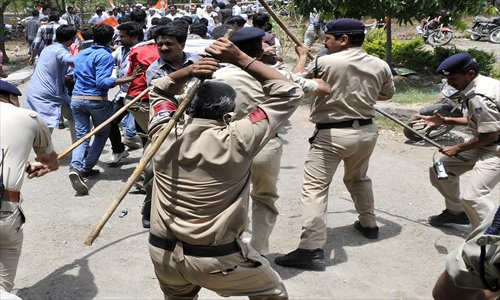HOME >> WORLD
Clear and present danger
By Sujoy Dhar Source:Global Times Published: 2013-8-15 0:53:02

Policemen cane-charge Congress party activists during a strike called by Congress party workers to protest against a Maoist attack, in Bhopal, India on May 27. Maoists opened fire on the Congress party Parivartan Yatra in Chhattigarh state on May 25. Photo: CFP
After massacring almost the entire top brass of India's ruling Congress party leadership in the central state of Chhattisgarh this May, Maoist rebels sent a clear message - we are far from being a spent force.
A decline in attacks preceding these incidents and security forces' success in eastern states like West Bengal had shifted the spotlight away from the Maoist rebels of India. But with their deadly strike in Chhattisgarh, the rebels, believed to be around 22,000 and living mostly in the forests, with their ideological patrons tucked away in big cities, proved everyone wrong.
While India emerged as the third largest economy in Asia, vast swathes of the country reeled under hunger and deprivation, paving the way for the Maoist rebels or the ultra-Left, to gain ground in the regions that comprise forest areas and their adjoining villages inhabited by the tribal people.
Beginnings
The Maoist movement began in the late 1960s in a northern town of West Bengal state called Naxalbari. While Kolkata was then the hub of the movement, with some of its best students signing up, it was crushed in the early 1970s. But it resurfaced as a more violent force that now operates under the name of the Communist Party of India (Maoist). India's Prime Minister Manmohan Singh calls them the biggest internal threat to the country.
Many regions of central and eastern India, known as the Red Corridor, became a symbol of the Maoist expansion in a majority of the 28 Indian states.
Their long Red Corridor stretches across several states - Chhattisgarh, Jharkhand, Bihar, West Bengal, Odisha - through jungles, over hills and into mineral-rich terrains and remote tribal villages plagued by hunger, police brutality and underdevelopment. The rebels are also active in parts of the western state of Maharasahtra while from India's north eastern state of Assam, more reports of Maoist activities pour in.
In the Bastar region of Chhattisgarh, the group of 500 Maoists killed, among others, anti-Maoist movement militia Salwa Judum's founder Mahendra Karma, who was also a senior Congress leader of the state. At least 32 others were seriously injured in the attack, including a former union minister. The Congress party, which rules India but is an opposition in the nationalist Bharatiya Janata Party (BJP) ruled Chhattisgarh, had launched a campaign in the election-bound state when the attack occurred on the convoy of vehicles.
No policy direction
Security analysts say India's inconsistent policy toward the Maoists is the cause of a festering problem and continuing bloodbath. They also feel that a decline in the attacks preceding the Chhattisgarh incident was no reason to be complacent.
"Whatever little reassurance could be derived from the absolute decline in levels of Maoist violence should now be abandoned. Total fatalities in 2013 already stand at 259 (by July 7), as against 367 for the whole of 2012," says Mrinal Kanta Das of the New Delhi-based Institute for Conflict Management.
Ajai Sahni, a counter-terrorism expert with the Institute for Conflict Management, is also skeptical, "When you ask if there is a flaw in the Maoist policy of India, I would say there is none because there simply is no policy to deal with Maoists in the first place."
"It must be a police-like response based on intelligence gathering. Instead of killing ordinary Maoist cadres like common fodder, get to the leadership of the Maoists. The Indian political leadership is so corrupt that they cannot think of someone who is not corrupt. You have to understand their leadership - which is unlike our mainstream political leaders - and target it," says Sahni.
While one of the prominent targets of the Maoists in Chhattisgarh was Mahendra Karma, experts and rights activists question the very formation of the Salwa Judum militia.
Salwa Judum, meaning "Peace March" or "Purification Hunt" in the Gondi language, was formed in Chhattisgarh by Mahendra Karma, who was a Congress leader, to fight the Maoists.
But in July 2011, the Supreme Court of India ordered its disbanding, calling it unconstitutional. By then, the militia had been blamed for several atrocities against tribal people.
According to Sahni, the recognition of Salwa Judum was a criminal abdication of state responsibility.
Poor development model
Rights activists in India, however, say the problem has its roots in a non-inclusive model of development that for decades worked against the forest people and tribes of India.
According to Binayak Sen, a well-known doctor who was incarcerated for years for allegedly acting as a courier for the rebels in Chhattisgarh state, corporate greed is displacing indigenous people all over India.
"They were dependent on common property resources and now their very survival is under threat, so they are putting up a resistance," opines Sen. According to Sen, large parts of India may be said to be in a perpetual state of famine.
Lalgarh in West Bengal was held by Maoist rebels for months in 2009. While the Indian security forces subsequently freed the region, the soul-crushing poverty witnessed in the area was shocking for this correspondent.
In one dirt-poor village, the correspondent met a bony villager with wobbly hands who identified himself as Balai Gharai. He said he begged in order to support his wife and children while another villager pointed out that in parched summer months they live in a drought-like situation with severe water scarcity.
With the Maoists openly declaring their intention of overthrowing Indian democracy through their armed struggle by 2050, the nation must get to grips with how it will curb the movement and go beyond paying lip-service to implementing inclusive development.
Posted in: Asia in Focus